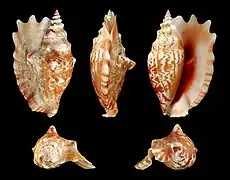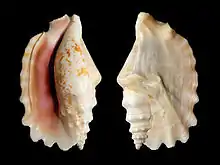| Sinustrombus sinuatus | |
|---|---|
 | |
 | |
| Views of laciniate conch shells | |
| Scientific classification | |
| Domain: | Eukaryota |
| Kingdom: | Animalia |
| Phylum: | Mollusca |
| Class: | Gastropoda |
| Subclass: | Caenogastropoda |
| Order: | Littorinimorpha |
| Superfamily: | Stromboidea |
| Family: | Strombidae |
| Genus: | Sinustrombus |
| Species: | S. sinuatus |
| Binomial name | |
| Sinustrombus sinuatus (Humphrey, 1786) | |
| Synonyms | |
Sinustrombus sinuatus, common name the laciniate conch,[1] is a species of sea snail, a marine gastropod mollusc in the true conch family, Strombidae.[2] It is native to the tropical Indo-Pacific region.
Description
The shell of S. sinuatus is thick and solid with a large body whorl.[3] The maximum length is 13 cm (5 in), but a more common size is 10 cm (4 in).[1] The short spire consists of about twelve whorls; the exterior of the shell is white, blotched or spotted with yellow, orange or light tan, and the interior is brown, purple or pink.[4] It is rather varied in morphology, with the lip of the aperture having a number of blunt finger-like processes, which vary from being almost unnoticeable to being prominent. The difference in shape of these variations is larger than the difference between the shape of this mollusc and the related species Lambis millepeda, Lambis scorpius and Lambis lambis, which it resembles.[3]
Distribution and habitat
Sinustrombus sinuatus is found in tropical and sub-tropical waters in southeastern Asia and Oceania. Its range extends from Sri Lanka and the eastern coast of India to the Philippines, Japan, Taiwan, Indonesia, Melanesia, Papua New Guinea and northern Australia.[1] Its typical habitat is a sandy substrate with algae and coral fragments in areas with low turbidity. It occurs from the low intertidal zone down to about 20 m (66 ft).[3]
Ecology
In the nineteenth century there was a widespread belief that members of the family Strombidiae were carnivorous but this proved to be false. S. sinuatus inhabits soft substrates where it feeds on fragments of algae, ingesting sand and detritus, and deriving its nutrition from the decomposing organic material.[5] It is an active mollusc, able to use its slender foot and robust operculum to flip itself off the seabed, in locomotion or defence.[6] Its operculum and the finger-like processes on the lip of the shell are also used in the behaviour involved in shell-righting.[7]
References
- 1 2 3 "Strombus sinuatus Humphrey, 1786: Laciniate conch". SeaLifeBase. Retrieved 6 June 2020.
- ↑ Bouchet, Philippe (2020). "Sinustrombus sinuatus (Lightfoot, 1786)". WoRMS. World Register of Marine Species. Retrieved 3 February 2020.
- 1 2 3 Silos, Rose-Ann C.; Manting, Muhmin Michael; Demayo, Cesar G. (2014). "Elliptic Fourier analysis in describing shell shapes of three species of Lambis (Gastropoda: Strombidae)" (PDF). Journal of Applied Science and Agriculture. 9 (11): 239–244. S2CID 2645468. Archived from the original (PDF) on 2020-02-03.
- ↑ Wieneke, Ulrich (26 September 2018). "Sinustrombus Sinuatus". Gastropoda Stromboidea. Retrieved 3 February 2020.
- ↑ Robertson, R. (1961). "The feeding of Strombus and related herbivorous marine gastropods". Notulae Naturae of the Academy of Natural Sciences of Philadelphia (343): 1–9.
- ↑ Latiolais, Jared M.; Taylor, Michael S.; Roy, Kaustuv; Hellberg, Michael E. (November 2006). "A molecular phylogenetic analysis of strombid gastropod morphological diversity" (PDF). Molecular Phylogenetics and Evolution. 41 (2): 436–444. doi:10.1016/j.ympev.2006.05.027. Archived from the original (PDF) on 2010-06-24. Retrieved 6 June 2020.
- ↑ Perron, F.E. (1978). "Locomotion and shell-righting behaviour in adult and juvenile Aporrhais occidentalis (Gastropoda: Strombacea)". Animal Behaviour. 26 (4): 1023–1028. doi:10.1016/0003-3472(78)90091-X.
External links
 Media related to Sinustrombus sinuatus at Wikimedia Commons
Media related to Sinustrombus sinuatus at Wikimedia Commons Data related to Sinustrombus sinuatus at Wikispecies
Data related to Sinustrombus sinuatus at Wikispecies